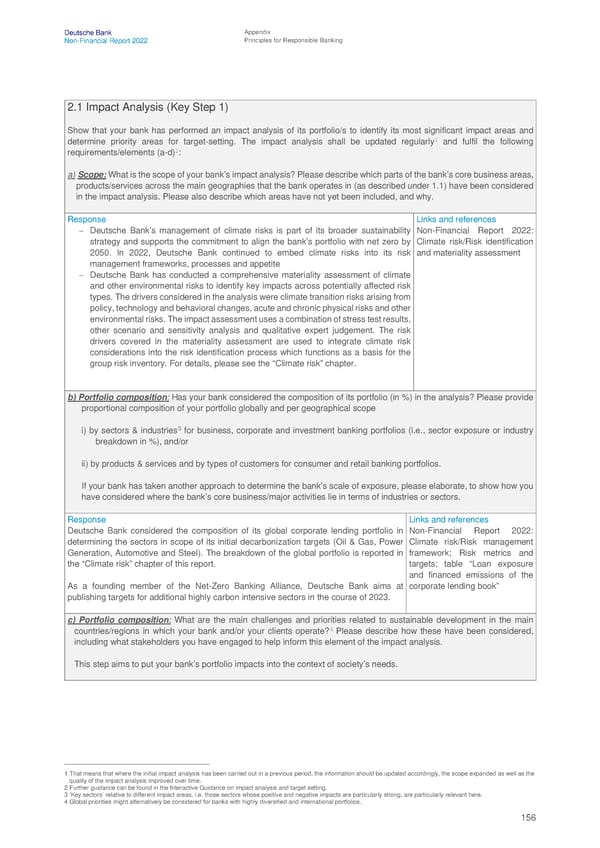Deutsche Bank Appendix Non-Financial Report 2022 Principles for Responsible Banking 2.1 Impact Analysis (Key Step 1) Show that your bank has performed an impact analysis of its portfolio/s to identify its most significant impact areas and 1 determine priority areas for target-setting. The impact analysis shall be updated regularly and fulfil the following 2 requirements/elements (a-d) : a) Scope: What is the scope of your bank’s impact analysis? Please describe which parts of the bank’s core business areas, products/services across the main geographies that the bank operates in (as described under 1.1) have been considered in the impact analysis. Please also describe which areas have not yet been included, and why. Response Links and references – Deutsche Bank’s management of climate risks is part of its broader sustainability Non-Financial Report 2022: strategy and supports the commitment to align the bank’s portfolio with net zero by Climate risk/Risk identification 2050. In 2022, Deutsche Bank continued to embed climate risks into its risk and materiality assessment management frameworks, processes and appetite – Deutsche Bank has conducted a comprehensive materiality assessment of climate and other environmental risks to identify key impacts across potentially affected risk types. The drivers considered in the analysis were climate transition risks arising from policy, technology and behavioral changes, acute and chronic physical risks and other environmental risks. The impact assessment uses a combination of stress test results, other scenario and sensitivity analysis and qualitative expert judgement. The risk drivers covered in the materiality assessment are used to integrate climate risk considerations into the risk identification process which functions as a basis for the group risk inventory. For details, please see the “Climate risk” chapter. b) Portfolio composition: Has your bank considered the composition of its portfolio (in %) in the analysis? Please provide proportional composition of your portfolio globally and per geographical scope i) by sectors & industries3 for business, corporate and investment banking portfolios (i.e., sector exposure or industry breakdown in %), and/or ii) by products & services and by types of customers for consumer and retail banking portfolios. If your bank has taken another approach to determine the bank’s scale of exposure, please elaborate, to show how you have considered where the bank’s core business/major activities lie in terms of industries or sectors. Response Links and references Deutsche Bank considered the composition of its global corporate lending portfolio in Non-Financial Report 2022: determining the sectors in scope of its initial decarbonization targets (Oil & Gas, Power Climate risk/Risk management Generation, Automotive and Steel). The breakdown of the global portfolio is reported in framework; Risk metrics and the “Climate risk” chapter of this report. targets; table “Loan exposure and financed emissions of the As a founding member of the Net-Zero Banking Alliance, Deutsche Bank aims at corporate lending book” publishing targets for additional highly carbon intensive sectors in the course of 2023. c) Portfolio composition: What are the main challenges and priorities related to sustainable development in the main 4 countries/regions in which your bank and/or your clients operate? Please describe how these have been considered, including what stakeholders you have engaged to help inform this element of the impact analysis. This step aims to put your bank’s portfolio impacts into the context of society’s needs. 1 That means that where the initial impact analysis has been carried out in a previous period, the information should be updated accordingly, the scope expanded as well as the quality of the impact analysis improved over time. 2 Further guidance can be found in the Interactive Guidance on impact analysis and target setting. 3 ‘Key sectors’ relative to different impact areas, i.e. those sectors whose positive and negative impacts are particularly strong, are particularly relevant here. 4 Global priorities might alternatively be considered for banks with highly diversified and international portfolios. 156
 Deutsche Bank Non Financial Report Page 156 Page 158
Deutsche Bank Non Financial Report Page 156 Page 158